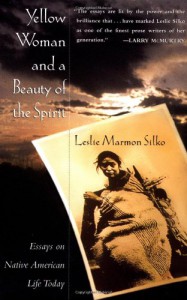

Bold and impassioned, sharp and defiant, Leslie Marmon Silko's essays evoke the spirit and voice of Native Americans. Whether she is exploring the vital importance literature and language play in Native American heritage, illuminating the inseparability of the land and the Native American people, enlivening the ways and wisdom of the old-time people, or exploding in outrage over the government's long-standing, racist treatment of Native Americans, Silko does so with eloquence and power, born from her profound devotion to all that is Native American.
Amazon.com
In this collection of essays, Silko, a member of the Pueblo Nation, discusses art, symbolism, and overall cultural growth within the Pueblo community. Some of the topics covered in Yellow Woman (the title of the book coming from one of the essays enclosed):
ART
* Symbolism in Pueblo art, ie. use of squash blossom on pottery designs = possible berringer of death, lightning imagery could mean good fortune, karmaj petals used for their symetry to represent four corners of the earth or four elements (fire, water, earth, air). Discussion of how some imagery is used to illustrate the earth being simultaneously complex and fragile
* "Yellow Woman" an image of Pueblo mythology, a goddess highly regarded for her bravery, strength, calm demeanor during catastrophe, and her "uninhibited sexuality" Rather than relying on violence and destruction to assure victories, "Yellow Woman" bewitches foes simply through her sensuality and self confidence.
FAMILY / SOCIETAL STRUCTURE & PREJUDICES
* Silko writes that her own family is a blend of Pueblo, Mexican and Caucasian and her own struggles of "not looking right" to any of these groups. She speaks lovingly of her "dark and handsome" great-grandmother who "exuded confidence and strength", but admits that the woman might not have been considered traditionally beautiful by either Caucasians or Pueblo people, which opens up an essay discussion for how beauty, the thing itself, is interpreted by different cultures. Silko notes that facial differences are highly prized among the Pueblo people.
*Discussion of how the idea of gender norms or "mens' work vs. womens' work" doesn't really have a place in Pueblo culture, only a matter of if you are able-bodied enough to get the job done.. so you find women doing construction and men doing basket weaving and child care. People just go where they are needed.
*Historically, Pueblo people were originally fine with sexual fluidity and up until the arrival of the Puritans, openly supported LGBTQ members of the tribe. Also, babies born out of wedlock were not an issue because unplanned or not, the life was honored as life. If not wanted by the biological parents, the newborn was simply given to a barren woman within the tribe to raise.
The discussions on art and culture were interesting but there was something quietly underneath that just had a feel of Silko sometimes talking down to her readers. Some of the essays repeat topics and even certain passages are duplicated verbatim from one essay into another, which I found incredibly disappointing and lazy. I know some of these pieces were previously printed elsewhere, but certain essays she must have been sitting on for a long while. For instance, one that is noted as having been previously published in 1996 -- "Auntie Kie talks about US Presidents and US Policy" -- but within that essay Silko talks about telling her aunt about an upcoming article Silko is to have published, "What Another Four Years Of Ronald Reagan Will Mean to Native Americans" (Reagan announced his Alzheimer's diagnosis in 1994).
So while some of the topics were interesting, I thought the collection as a whole was kind of sloppily put together. Also, if you haven't read any of Silko's fiction, there are spoilers for some of her short stories within these essays.









